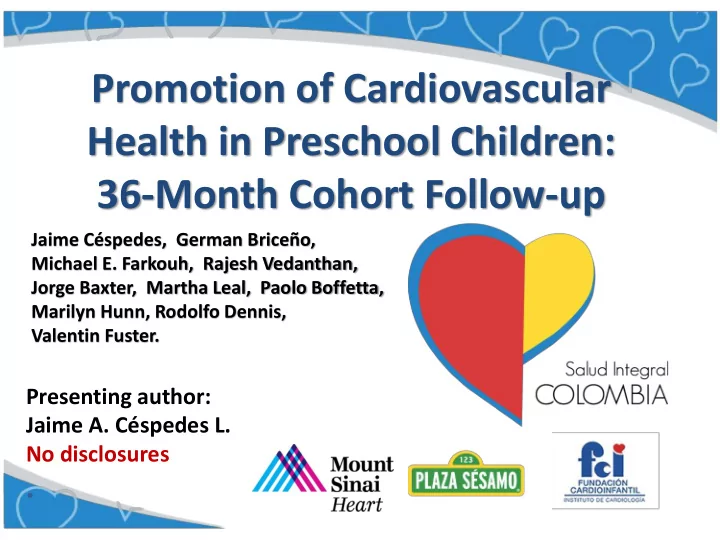

Promotion of Cardiovascular Health in Preschool Children: 36-Month Cohort Follow-up Jaime Céspedes, German Briceño, Michael E. Farkouh, Rajesh Vedanthan, Jorge Baxter, Martha Leal, Paolo Boffetta, Marilyn Hunn, Rodolfo Dennis, Valentin Fuster. Presenting author: Jaime A. Céspedes L. No disclosures .
Background • CVD leads to mortality worldwide / Colombia • Lifestyle changes (diet, sedentary behaviour) • CVD risk factors identifiable in childhood • Age 3-5 years is a window of opportunity to effectively intervene for subsequent health behavior. • Accordingly, our intervention targeted preschoolers _________________________________________________________________________________________________________________ Murray CJL, Lopez AD . N Engl J Med :2013;369: 5, 448-457. Lim SS, etal. GBD 2010 Lancet :2012; 380: 2224 -60. Gluckman PD, Hanson MA, Thornburg KLN . Engl J Med 2008;359:61-73 Céspedes JA, Fuster VF, etal.: AJM. 2013; 126: 1: 27 -35e. 2 Céspedes JA, Fuster VF, etal.: AJM. 2013; (in press).
Setting Multicomponent Pedagogical strategy focused on key messages Low SES Children: 3-5 yrs Female led households Endpoint: 6-8 yrs 40 hours Parents : 30.7 yrs Heart & Body Diverse & Physical awareness balanced nutrition activity _________________________________________________________________________ Céspedes JA, Fuster VF, etal. AJM. 2013; 126: 1: 27 -35e
Intervention Teachers Children Parents
Combined RCT - Cohort follow up 14 305 school facilities Cluster RCT Cohort 100 Intervention Follow-up 90 21 weeks Score (mean) p<0.001 Children 80 N=598 p<0.001 p<0.001 70 p=0.2 60 Baseline 6 m 18 m 36 m May Nov. Nov. May 2009 2009 2010 2012
Study measurements - Outcomes Educational areas : Evaluation areas 1- Heart and Body 1- K nowledge 2- Nutrition 2- A ttitudes 3- Physical activity 3- H abits Mean change on children’s KAH scores over time Change in children’s nutritional status K: Cumulated sum of information acquired over time. A: Learned predisposition to behave in a consistent way. H: Learned responses which are regularly manifested (physical activity, etc). _________________________________________________________________ Céspedes JA, Fuster VF. et al. AJM, 2013; 126: 1: 27 -35e . 6
Results - 1 36m- change in children’s KAH mean scores* 100.0 p< 0.001 90.0 p< 0.001 Score (mean) 80.0 p< 0.001 70.0 p< 0.001 60.0 p< 0.001 p< 0.001 50.0 40.0 0 Scientific time (months) 18 36 Knowledge Attitudes Habits (physical activity) *0 – 100 scale Adjusted by sex and age of children, group, socioeconomic status, age of parents, age and educational level of teachers .
Results - 2 36m- change Children’ s Knowledge mean scores* 100.00 ∆ from 16.70 10.60 4.80 13.20 10.50 95.00 Baseline 90.00 85.00 80.00 75.00 70.00 36 months 18 months 65.00 Baseline 60.00 3 4 5 Girls Boys Age (Years) Sex * adjusted by age and sex covariates
Results - 3 36m-change Children’s nutritional status* Baseline 18 months 36 months (%) (%) (%) p value* Nutritional status Underweight 15.5 12.3 3.3 <0.0001 Eutrophic 62.1 64.6 75.0 <0.0001 Overweight / obese 22.4 23.1 21.7 0.7354 * % of Eutrophic CDC growth charts BMI/age-sex: Underweight: -2 SD and < - 1 SD, Eutrophic: -1 SD and +1 SD, Overweight: > +1 and +2SD, Obese: >+2SD
Results - 4 36m-change Parent’s KAH mean scores Score (mean) 85.0 P<.001 75.0 P<.001 65.0 P<.001 55.0 Scientific 0 18 36 time Knowledge Attitudes Habits Delta from Baseline: Knowledge:3.5, Attitudes:3.4, Habits: 2.7
Conclusions This pre-school based intervention maintains a positive change in children’s knowledge, attitudes and habits after 36 months This study contributes to the mounting evidence for the effectiveness of similar interventions initiated at preschool years and could represent a critical period for cardiovascular health promotion
Limitations Such projects are challenging due to the high migration of families and children moving to new schools Because of the original significant benefit obtained on the intervened group, we were obliged to later deliver the interventional strategy to the control group, as well There is limited data collection on dietary habits; this will be addressed in the follow-up program
Recommend
More recommend